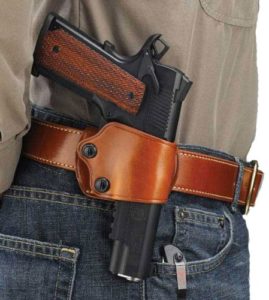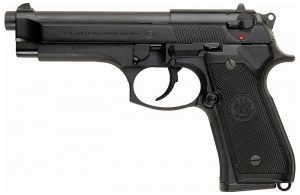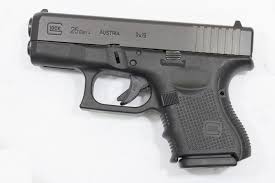Gear up for a little gun porn, folks. It’s been a while since I’ve ranted about mistakes authors make when writing about guns, so I thought I’d stir things up a little.
Cla-shack. When I say it out loud, it is exactly the sound that a well-tuned pump-action  shotgun makes when you work the bolt. It’s very dramatic on the page or on the screen, and it is unmistakable in real life. How many times have we seen that moment when our good guy with a shotgun confronts the armed bad guy he’s been looking for and then, when they’re face-to-face . . . cla-shack “Freeze!”?
shotgun makes when you work the bolt. It’s very dramatic on the page or on the screen, and it is unmistakable in real life. How many times have we seen that moment when our good guy with a shotgun confronts the armed bad guy he’s been looking for and then, when they’re face-to-face . . . cla-shack “Freeze!”?
I watch those scenes and wonder what kind of moron searches for a bad guy without a round in the chamber, ready to fire? Why walk into a gunfight with your gun unloaded?
Remember that very dramatic scene in The Fugitive (the 1993 movie version) when Richard Kimble is making his getaway from City Hall with Marshal Sam Gerard right behind? In that chase, we see Gerard pull his Glock from its holster and he racks a round into the chamber. Then as Kimble dives through the bullet proof glass barrier doors, Kimble’s foot gets clamped between the doors and Gerard fires four or five times into the glass. Very thrilling, but why didn’t he shoot the sole of Kimble’s foot, which was still inside the glass? Okay, that last part is for a future post.
Understanding that the average gunfight lasts less than five seconds, and at a range of 7-10 feet, every cop I know carries his or her pistol in what’s called “condition one”, which means there’s a round in the chamber and the safety is on.
“But John!” someone shouts. “Everybody knows there’s no safety on a Glock!”
Not so, I reply. There are actually three safeties on a Glock. They’re internal. There’s a trigger safety, a firing pin safety and a drop safety. You can throw a chambered Glock against a concrete floor as hard as you want, and it won’t go off accidentally. Yet, if you pull the trigger intentionally, it will fire every time. And that’s the point. When someone is about to kill you, you don’t want a lot of intermediate manipulations to get in the way of returning the favor.

This is a “1911 platform” pistol in Condition One. Note that the hammer is cocked, and the thumb safety is engaged. This is often called “cocked & locked.”
If you’re going to include firearms in your writing, it’s important to know the peccadillos of your character’s chosen pistol (or rifle, for that matter).
My character Jonathan Grave carries a Colt 1911, always in Condition One, which also called “cocked and locked.” When confronted by a bad guy, all he has to do is draw, thumb the safety (press down on the lever next to the hammer) and shoot.
Many gun manufacturers use the 1911 platform for pistols in pretty much any caliber. Among the characteristics they all share is the fact that they are single action only (SA), meaning that unless the hammer is cocked, the weapon will not fire. Thus, when you see a character carrying a pistol that looks anything like the one in the picture, but the hammer is down, it is not ready to shoot.

Many pistols like this Beretta 92 (military M9) are double action on the first round, and single action thereafter.
On the other hand, there are many pistols with hammers, such as the Beretta M9, where carrying with the hammer down does not impede quick deployment. That’s because these pistols are both double action and single action (DA/SA). With a bullet in the chamber, and the hammer down, the first pull of the trigger pulls the hammer back and then releases it to strike the firing pin. Then, after the slide operates to eject the round, the hammer remains cocked and ready to shoot as a single action pistol. The tricky part is that that initial pull on the trigger is very hard, and then the pull is very light for the follow-up shots. As a result, for me, anyway, accuracy suffers because of the lack of a consistent trigger pull.
As I’ve written before in this space, if verisimilitude is important to you, and you’re going to write about firearms, don’t go with what you see on TV or in movies. Get thee to your local shooting range and rent your character’s gun for an hour and shoot it. If you’re not familiar with shooting, the staff will be happy to help you out.
All questions and comments are welcome.


Excellent, both info and advice. Thanks, John. Shared widely with other writers.
Thanks for that, Harvey!
I always enjoy your posts, John. The gun myths perpetuated in movies shouldn’t invade our books. Suppressors that are whisper silent and targeting specific body parts of a running villain are another couple of pet peeves of mine.
Thanks, Tom.
And there’s a pernicious aspect to those misrepresentations on the screen. Juries and plaintiff’s attorneys ask people who were in the throes of defending themselves from a lethal attack why they shot the attacker in the chest, thus killing him, instead of shooting him in the leg or the shoulder to wound him.
Yep. Shoot until the threat is eliminated. Center mass every time. It drives me crazy when you hear someone on the news talking about an officer-related shooting say, “They didn’t have to kill him. Why not just wound him instead?”
Great information from a trusted source. Thanks, once more, John.
Thanks, John. When I wrote my debut novel I had never fired a weapon, so I watched endless YouTube videos about various types of guns, the proper way to hold a weapon, stance, etc … I can’t recall how long it took me, but it felt like days. Then I smartened up and asked a (former military) neighbor to “show me the ropes.” I learned more in that one day than in all the time I spent on YouTube. There’s no substitution for real life experience.
Until you feel the recoil, you can’t know what you’re talking about.
Fantastic advice!
That dramatic round chambering irritates me every time I see it in a movie.
Love your specifics on the trigger pull, too.
Outstanding, John. I knew most of this, but I still learned a couple of things and it always good to have some validation, particiuarly when one of my main characters routinely carries an M1911 Colt.
When I said (to myself but aloud) that one of these days, I’d have to fire a gun so I’d know what my heroine would experience if the hero hands her his gun and says, “If anyone but me comes back through that door, shoot him.” (Not that I’ve ever written that scene.)
The Hubster overheard and immediately made an appointment for a gun class at a local shooting range. This was Florida, and a side story is that the class was for getting a concealed carry permit and consisted of 3 hours of video. The instructor, at the end, asked if I practiced often and I said I’d never held a gun. That’s when he asked if I wanted to, and set me up with an instructor. Scary to think that 3 hours of video plus fingerprinting and a background check was all Florida required for a permit.
At any rate, what I soon discovered (aside from outshooting the Hubster) was that my hands are too small to thumb the safety off any weapon I’ve ever tried. of course, if I wanted a gun for myself, I’d make sure I would choose one that wouldn’t require that, but unlike undergoing a nephrectomy (see my comment yesterday), hands-on research is always better than books, YouTube or even talking to experts.
Thank you.
I’m convinced my husband is going to die of a stroke caused by yelling at idiot reporters who think an ear plug is a bullet. He’s an expert marksman, as is our son. I’ve learned a lot by listening to their rants.
The only weapons I know well are my own little Ruger, the shotgun we used to shoot water moccasins and copperheads at the lake house, the M-16 we used at basic, and the rifle that stayed in the hall closet (when I was growing up) until it was needed.
An antique rolling pin hurled without warning can also do a fair amount of damage.
It’s hard to hurl that rolling pin at 1800 feet per second, though! 🙂
Helpful info, John. Always appreciate your specific examples.
I’m taking you up on your offer to answer a question. Situation: a bad guy wearing a ski mask is lunging toward the heroine. She has an S&W Chief and first shot is snake shot (she planned to go for a hike, not get in a gun fight). If she fires snake shot at his eyes at a range of 3-4 feet, how disabling is that? Will it blind him?
Thanks!
Well, they say a video is worth a thousand words. Or something like that. The quick answer is, yes, it will likely blind him, so long as the aim is true. Here’s a video (no blood involved) of .38 caliber rat shot in use at the range: https://youtu.be/vYt6P6hF6LQ?t=89
Exactly what I needed. I’ll add the wad hitting the eye too. Thank you, John!
Now, fair warning: You’ve got some explaining to do why your heroine is packing rat shot instead of bullets in a snub-nose,
She’s an amateur sleuth, not a pro, who planned to hike in an area with rattlers and didn’t expect a human ambush. First two shots are snake shot, the rest are hollow points. She scores three out of five shots against two armed attackers at close range, wounding and scaring them off.
Thanks again, John!
Had this very conversation with retired LAPD cop last Saturday, about cops not having a round in the chamber, etc. On the street he carried a Beretta M9 and also a backup .38 Smith & Wesson. The conversation started when I mentioned how every cop show and movie ever made has the arrestee given the Miranda advisement the moment the cuffs are slapped on. It’s dramatic, like a shotgun blast sending a body through a wall, but is just not real life.
Revolvers can be a whole different story, depending on the make. Of the dwindling few people I know who carry revolvers with hammers, most keep the the hammer on an empty chamber. You still get a shot on the first trigger-pull, but there’s one fewer bullet in the cylinder.
I had zero experience with guns until I went to a firing range, sponsored by SleuthFest writers con one year. Great experience with 10-12 cops, FBI guys, there answering every question and showing us how to handle and fire guns of every kind and caliber. I shot seven different guns. Did best with a Glock. But the biggest thing I learned was to ASK THE EXPERTS whenever I write about guns. I have a couple on call. I run everything by them. Have never had a reader write to say gotcha — yet.
Another movie cliche — what’s with the bad-ass dudes firing their guns sideways?
On firing guns sideways . . . As training classes advance in sophistication and challenges, you learn to shoot effective with your off-hand (non-dominant hand). I have learned through these exercises that I am ridiculously right-dominant, to the degree that I really can’t aim effectively with my left eye. Since I’m forced to use my right eye, the only way to aim the pistol is gangsta-style. The recoil is hard to control, but I can hit what I’m shooting at. As long as the rear sights align with the front sights, the bullet will go where you’re pointing.
John-
Great stuff as always.
II am curious about your reference to working the “bolt” of a pump action shotgun. I thought that term applied to the much different mechanism such as in a Lee-Enfield rifle. I thought the shotgun’s action would be referred to as working the “pump” or “slide“.
Am I mistaken?
Thanks – tom combs
PS – any reports on TKZ alumni John Ramsey Miller? Miss his contributions and humor.
Pump-action long guns (there are pump action rifles, too) are often called shuckers or pump guns. But as far as I know, the pump or the slide (a term I’ve heard far more often for pistols) are the mechanism by which one cycles the bolt. I could be wrong here.
As for JRM, he’s still kickin’ around, as ornery and hysterically funny as ever. He’s got a bunch of grandkids now, and he’s working a very successful T-shirt business with his sons. I think he’s writing again, but I’m not sure.
Thanks!
Good to hear JRM doing well.
Seemed like the rare kind of guy who if he’s breathing, he’s funny.
A great alumnus…
My thanks as well. One way to sell the incredulous parts of your story (think Jason Bourne and Tredwell) is to surround it with accuracy. When I have a gun in my work I always read all I can on that particular model and You Tube videos help. But I rely on adding in my own experience from the Marine Corps. I spent two weeks as the duty corpsman at the firing ranges at Camp Pendleton. I got to fire everything even a 3.5 inch rocket launcher. Loud.
Other gun BS in the movies:
The twenty-five shot revolver.
Shooting the gun out of the hand of the bad guy from a hundred feet away.
The fifty yard kill shot with a gun the shooter has just picked up for the first time.
The shot that sends the victim flying backward into a wall.
The “John Wick” fantasy gunfight that resembles a ballet with bullets (every shot is a kill shot). Guilty pleasure: I enjoyed the same sort of BS in Atomic Blonde, but I’m head or heels for Charlize Theron. I know, I know I’m a pig
Confession: I adore the John Wick movies. I especially like the world they’ve created. I don’t know if you’ve seen Keanu Reeves in his 3-gun tournament, but the guy’s got some pretty mad gun skills.
I liked them, too.
I love your gun posts, John. I especially like to read the jargon like “Condition One” & “cocked & locked.” It’s important for me to hear or read the descriptors (the slang) of the gun world & how handling differs with each weapon.
I often get a sense of my characters & what specific weapon(s) they would carry. A Beretta has an elegance to it and a Colt Python can be a fierce looking weapon in the hands of the right woman. Sometimes it’s important to have a feel for how a weapon can be concealed when wearing a tuxedo or an evening gown.
Do you choose a weapon for a specific character because you can imagine their preferences? If so, a good future post might be what type of character would choose a weapon like the Colt 1911, for example. This could also be helpful if you could show “weapons of choice” for women or teens with smaller hands.
Your posts & the images are GOLD. Thank you, John.
Thanks, Jordan. I like that idea for a future post!
My husband could talk for hours with you about guns. He is just as disgusted with Hollywood. He rarely watches cop or detective movies because not only do they usually picture the gun fights wrong, it annoys him when they use the wrong gun, especially in historical or period pieces. If they get it right, they’ve won a true fan.
Poor guy, he married a woman who didn’t know a rifle from shot gun. You can bet I know the difference now. He’s also taught me how to shoot various guns since he has a personal arsenal locked up in a huge gun safe. I should mention he is former Marine (Tanks) and retired police officer (34) years, and knows guns and gun safety intimately. However, I’ve seen pictures of him as a little boy. What did he have in hands, even back then? I bet I don’t have to tell you.
Very interesting post, as always. My husband maybe a walking encyclopedia of guns and ammo, but he has no imagination when it comes to fiction writing and his need for absolutes doesn’t leave much room for possibilities. Sometimes I have to say, “Just tell me, is it a possible scenario or not, and why.”
Thanks, John.
Pingback: Author Inspiration and This Week’s Writing Links – Staci Troilo